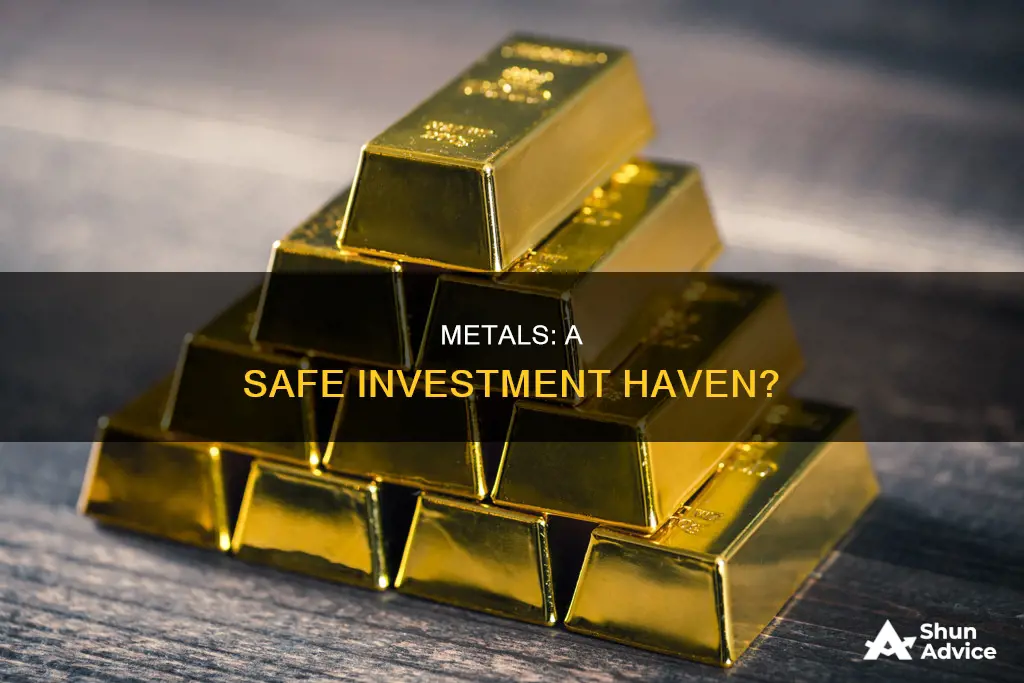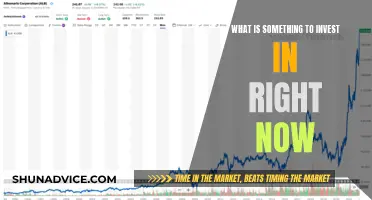
People have been investing in precious metals for thousands of years, but why? Well, gold, silver, and platinum are the most popular options, thanks to their stability, historic value, and the fact that they are a tangible asset. They are also a good hedge against inflation and volatile markets. Precious metals are a good way to diversify your portfolio and, in some countries, there are tax advantages to investing in them.
| Characteristics | Values |
|---|---|
| Diversification | Metals like gold and silver are used to diversify investment portfolios. |
| Store of Value | Precious metals are a store of value, especially during economic uncertainty. |
| Collectibles | Metals like gold and silver are often used to create jewellery and other decorative items, which can be sold for a profit. |
| Tax Advantages | Some countries offer tax advantages for those who invest in precious metals. |
| Hedge Against Inflation | Metals like gold and silver are stable during inflation and economic uncertainty. |
| High ROI | Precious metals offer a high potential for return on investment. |
| Low Risk | Metals like gold and silver are less risky than stocks. |
What You'll Learn

Metals are a good hedge against inflation
Gold, silver, and other precious metals have been considered valuable commodities for thousands of years. They have been viewed as symbols of wealth and prosperity, and their value has only increased over time. In recent years, there has been a rise in demand for precious metals worldwide, and they are now more accessible to the average person than ever before.
Precious metals have held their purchasing power over time, and they are worth considering as a hedge against inflation. Gold, silver, palladium, and platinum have all performed well historically and have outperformed inflation rates. For example, gold prices have climbed steadily since 2016, with a few corrections along the way. In the last quarter of 2020 and early 2021, the price hovered between $1,800 and $2,000 per troy ounce. This would have provided a favourable increase to an investor's net worth, even when factoring in inflation. Silver has also performed well, with consistent increases from 2016 to 2021, representing a 65% return over four years, outperforming inflation.
Palladium prices have been on a steady upward trajectory since the 1980s, and while platinum prices have remained relatively steady in the past four years, there have been some extreme highs and lows that could have provided a nearly 108% return on investment.
Precious metals have intrinsic value and are unique in terms of inflationary protection. They also have no credit risk, and their prices will likely continue to climb as long as economic uncertainty persists. Investing in precious metals can help reduce overall risk and volatility in an investment portfolio.
However, it is important to note that some analysts believe that the ability of precious metals to hedge against inflation has been exaggerated. While metals tend to perform better with moderate inflation and declining rates, their prices may weaken with rising inflation and yields.
Young Investors: Why the Hesitation?
You may want to see also

They are a tangible, stable asset
Metals are a tangible asset, meaning they are items that can be physically touched and interacted with. This is in contrast to intangible assets, such as intellectual property, copyrights, and brand recognition, which are non-physical in nature. Tangible assets are often favoured as they hold "real" value and have a real-world application that increases their value.
Metals are also a stable asset, as they are less susceptible to market demand and technological advancements than intangible assets. They are more stable investments due to their consistent underlying use and their value is often underpinned by their intrinsic worth and physical qualities. For example, gold is widely recognised as an economic asset and can be used for exchanges.
The value of metals is also driven by their finite nature, as they have a discrete value that can be transacted for monetary value. This is especially true of precious metals, which have been considered valuable throughout history.
In addition, metals are a good investment because they provide portfolio diversification. As tangible assets, they often move in the opposite direction to financial assets like stocks or bonds. This means that they can act as a hedge against inflation or other economic uncertainties.
Finally, metals are a stable investment because they are less liquid than financial assets, meaning they take longer to sell and have higher transaction fees. This can provide a safety net for investors, as it means that the value of metals is less likely to fluctuate rapidly.
Investments of Passion: Collectibles
You may want to see also

Metals have a high potential for ROI
Gold, in particular, has a limited supply, and its value is expected to retain value over time. This is because, unlike paper currency, gold cannot be created in a lab and so its supply is finite. This makes it a good hedge against inflation. While the price of gold and other precious metals can be volatile, with unstable returns, over the long term, they have shown an ability to keep up with inflation and provide a decent return on investment. For example, an analysis of precious metal spot prices over 100 years suggests an average yearly return of 3-4%, with 10-year bursts seeing average yearly returns as high as 15-20%.
Additionally, investing in precious metals can provide a safety net during times of economic uncertainty. They are a tangible, physical asset that can be exchanged or liquidated quickly. This makes them a good investment option for those seeking to diversify their portfolios and protect their investments during uncertain times.
Finally, the mining sector, from which metals are sourced, is known for its high potential returns. This is especially true for precious metals royalties, which provide holders with a percentage of a mine's revenue for the life of the project, as well as exposure to the mine's production increases and resource expansion. For example, Franco-Nevada's royalty on the Goldstrike mine provided exceptional returns, paying over $1 billion in revenue and returning 500 times the initial investment.
In conclusion, investing in metals can provide a high potential for ROI due to their intrinsic value, limited supply, ability to hedge against inflation, and the high returns offered by the mining sector.
Who Invests in the Stock Market?
You may want to see also

Metals are rare and valuable
Metals are considered precious if they are rare and valuable. The best-known precious metals are gold and silver, which have been used as currency and in art since before recorded history. Other precious metals include the platinum group metals: ruthenium, rhodium, palladium, osmium, iridium, and platinum.
The rarity of a metal is best expressed as its 'mass fraction', or how many kg can be expected to be found per billion kg of crust material. Gold has a mass fraction of 4 parts per billion, silver 75 parts per billion, platinum 5 parts per billion, and osmium 1.5 parts per billion.
Precious metals are also defined by their natural occurrence, with unstable elements created in a lab unable to be considered precious. They are further distinguished by their value, which is driven by industrial usage, scarcity, and cost of procurement.
The demand for precious metals is influenced by their practical use, their investment potential, and their ability to store value. They are often seen as a hedge against inflation and economic downturns.
Rhodium, for example, is highly valuable due to its rarity and its essential role in automotive catalytic converters. Similarly, palladium is widely used in catalytic converters for diesel vehicles, making it more valuable than platinum despite being less well-known.
Gold and silver are also desirable for their use in jewellery, art, and coinage. They have industrial applications in electronics and technology, and gold is even used in medicine due to its harmlessness to the body.
The accessibility of investing in precious metals has increased in modern times, with online shopping and globalisation playing a significant role in their popularity.
What Your Neighbors Are Investing In
You may want to see also

They are a good diversification for your portfolio
Metals are a good diversification for your portfolio. This is because they are a safe-haven asset during times of economic turmoil and market volatility. When traditional investments like stocks and bonds are underperforming, investors often turn to precious metals as a store of value. Their intrinsic worth, enhanced performance, and physical form can provide stability in uncertain times.
Precious metals, particularly gold, have long been recognised as effective hedges against inflation. As the value of fiat currencies erodes over time due to inflation, the purchasing power of gold tends to hold steady or even increase. Including gold in your portfolio helps protect your wealth from the eroding effects of inflation.
Precious metals have demonstrated their ability to retain value over centuries. This long-term store of value can be particularly appealing for investors looking to preserve their wealth for future generations. They are also highly liquid assets. You can easily buy or sell them in various forms, such as coins, bars and rounds, making it convenient to adjust your portfolio as needed.
Additionally, diversification is a strategy that involves spreading your investments across various asset classes, industries, and geographic regions. The primary goal of diversification is to reduce the risk associated with investing while potentially increasing returns over time. By spreading the risk, rather than sticking to a single asset class, you can minimise the impact of poor performance.
EPZ Investments: Why People Take the Risk
You may want to see also
Frequently asked questions
Investing in metals can be a good way to diversify your portfolio and grow its value over time. Metals are a tangible asset that can be relied on during economic uncertainty and are often seen as a store of value. They also have collectible value and can be used as a currency.
Some of the risks of investing in metals include price volatility, storage and insurance costs, potential underperformance, and the fact that they don't generate income.
Gold is the most well-known and investable precious metal. It has a long history as a store of value and is recognised as a valuable commodity worldwide. Gold is also durable, shapeable, and a good conductor of heat and electricity.
Silver, platinum, and palladium are also popular choices for investors. Silver is an important industrial metal with electrical properties that make it vital in solar panels. Platinum is essential in the automotive industry, while palladium is used in electronics and industrial products.







